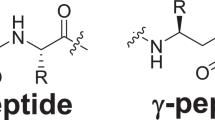Abstract
Amyloid A amyloidosis is a life-threatening complication of a wide range of chronic inflammatory, infectious and neoplastic diseases, and the most common form of systemic amyloidosis worldwide. It is characterized by extracellular tissue deposition of fibrils that are composed of fragments of serum amyloid A protein (SAA), a major acute-phase reactant protein, produced predominantly by hepatocytes. Currently, there are no approved therapeutic agents directed against the formation of fibrillar SAA assemblies. We attempted to develop peptidic inhibitors based on their similarity and complementarity to the regions critical for SAA self-association, which they should interact with and block their assembly into amyloid fibrils. Inh1 and inh4 which are comprised of the residues from the amyloidogenic region of SAA1.1 protein and Aβ peptide, respectively, were found by us as capable to significantly suppress aggregation of the SAA1-12 peptide. It was chosen as an aggregation model that mimicks the amyloidogenic nucleus of SAA protein. We suppose that aromatic interactions may be responsible for inhibitory activity of both compounds. We also recognized that aromatic residues are involved in self-association of SAA1-12.







Similar content being viewed by others
References
Ashim P, Bhanita S, Tanmay M, Kishore T, Sandip P, Bhubaneswar M (2015) Med Chem Commun. doi:10.1039/c5md00466g
Austen B, Paleologou K, Ali S, Qureshi M, Allsop D, El-Agnaf O (2008) Designing peptide inhibitors for oligomerization and toxicity of Alzheimer’s β-amyloid peptide. Biochemistry 47:1984–1992
El-Agnaf O, Paleologou K, Green B, Abogrein A, King J, Salem S, Fullwood N, Benson F, Hewitt R, Ford K, Martin F, Harriott P, Cookson M, Allsop D (2004) A strategy for designing inhibitors of α-synuclein aggregation and toxicity as a novel treatment for Parkinson’s disease and related disorders. FASEB J 18:1315–1317
Fung SY, Keyes C, Duhamel J, Chen P (2003) Concentration effect on the aggregation of a self-assembling oligopeptide. Biophys J 85:537–548
Gazit E (2002) A possible role for π-stacking in the self-assembly of amyloid fibrils. FASEB J 16:77–83
Gillmore JD, Lovat LB, Persey MR, Pepys MB, Hawkins PN (2001) Amyloid load and clinical outcome in AA amyloidosis in relation to circulating concentration of serum amyloid A protein. Lancet 358:24–29
Kishore D, Kundu S, Kayastha AM (2012) Thermal, chemical and pH induced denaturation of a multimeric β-galactosidase reveals multiple unfolding pathways. PLoS One. doi:10.1371/journal.pone.0050380
Lu J, Yu Y, Zhu I, Cheng Y, Sun PD (2014) Structural mechanism of serum amyloid A-mediated inflammatory amyloidosis. Proc Natl Acad Sci USA 111:5189–5194
Marshall KE, Morris KL, Charlton D, O’Reilly N, Lewis L, Walden H, Serpel LC (2011) Hydrophobic, aromatic, and electrostatic interactions play a central role in amyloid fibril formation and stability. Biochemistry 50:2061–2071
McAdam KPWJ, Sipe JD (1976) Murine model for human secondary amyloidosis: genetic variability of the acute-phase serum protein SAA response to endotoxins and casein. J Exp Med 144:1121–1127
Merlini G, Seldin DC, Gertz MA (2011) Amyloidosis: pathogenesis and new therapeutic options. J Clin Oncol 29:1924–1933
Parmelee DC, Titani K, Ericsson LH, Eriksen N, Benditt EP, Walsh KA (1982) Amino acid sequence of amyloid-related apoprotein (aposaa1) from human high density lipoprotein. Biochemistry 21:3298–3303
Pauthe E, Pelta J, Patel S, Lairez D, Goubard F (2002) Temperature-induced [beta]-aggregation of fibronectin in aqueous solution. Biochim Biophys Acta 1597:12–21
Perugia E, Monticelli E, Rubinraut S, Kapitkovsky A, Fridkin M (2009) The amyloidogenic domains of the human serum amyloid A protein—new insights. In: Del Valle A et al (eds) Peptides for youth: the proceedings of the 20th American peptide symposium, pp 69–70, Springer Science + Bussiness Media
Röcken Ch, Shakespeare A (2002) Pathology, diagnosis and pathogenesis of AA amyloidosis. Virchows Arch 440:111–122
Rubin N, Perugia E, Wolf SG, Klein E, Fridkin M, Addadi L (2010) Relation between serum amyloid A truncated peptides and their suprastructure chirality. J Am Chem Soc 132:4242–4248
Sipe JD, Benson MD, Buxbaum JN, Ikeda S, Merlini G, Saraiva MJM, Westermark P (2010) Amyloid fibril protein nomenclature: 2010 recommendations from the nomenclature committee of the International Society of Amyloidosis. Amyloid 17:101–104
Tu L-H, Raleigh DP (2013) Role of aromatic interactions in amyloid formation by islet amyloid polypeptide. Biochemistry 52:333–342
van der Hilst JCH, Yamada T, Op den Camp HJM, van der Meer JWM, Drenth JPH, Simon A (2008) Increased susceptibility of serum amyloid A1.1 to degradation by MMP-1: potential explanation for higher risk of type AA amyloidosis. Rheumatology 47:1651–1654
Westermark PT, Engström U, Westermark P (1992) The N-terminal segment of protein AA determines its fibrillogenic property. Biochem Biophys Res Commun 182:27–33
Yamamoto K-I, Migita S (1985) Complete primary structures of two major murine serum amyloid a proteins deduced from Cdna sequences. Proc Natl Acad Sci USA 82:2915–2919
Zandomeneghi G, Krebs MRH, McCammon MG, Fändrich M (2004) FTIR reveals structural differences between native β-sheet proteins and amyloid fibrils. Protein Sci 13:3314–3321
Acknowledgments
This work was financially supported by grants of the National Science Center 2011/03/N/NZ5/01460 and the University of Gdansk DS 530-8725-D496-15.
Author information
Authors and Affiliations
Corresponding author
Ethics declarations
Conflict of interest
The authors have no conflicts of interest to declare.
Ethical statement
This article does not contain any studies with human participants or animals performed by any of the authors.
Additional information
Handling Editor: J. D. Wade.
Electronic supplementary material
Below is the link to the electronic supplementary material.
Rights and permissions
About this article
Cite this article
Sosnowska, M., Skibiszewska, S., Kamińska, E. et al. Designing peptidic inhibitors of serum amyloid A aggregation process. Amino Acids 48, 1069–1078 (2016). https://doi.org/10.1007/s00726-015-2167-y
Received:
Accepted:
Published:
Issue Date:
DOI: https://doi.org/10.1007/s00726-015-2167-y




